Applying Geostatistics to Understand Seismic Activity Patterns in the Northern Red Sea Boundary Zone
Abstract
1. Introduction
2. Seismotectonic Framework
3. Related Work and Methodology
3.1. Average Nearest Neighbor (ANN)
3.2. Quadrat Count Analysis (QCA)
3.3. Global and Local Moran’s I
3.3.1. Spatial Weight Matrix
3.3.2. Global Moran’s I (GMI)
3.3.3. Local Moran’s I
3.4. Categorization of Concentrated Activity Areas
3.4.1. Getis-Ord Gi*
3.4.2. Kernel Density Estimation (K)
4. Experimental Design
- Saudi Seismic Network Catalog:
- Import the seismic data from the Saudi Seismic Network catalog.
- Identify unique events using distinctive event identifiers, such as event IDs and timestamps.
- Exclude redundant events within to streamline the dataset.
- Egyptian Seismic Network Catalog:
- Import seismic data from the Egyptian Seismic Network catalog.
- Identify events unique to Egyptian catalog using specific event identifiers for cross-referencing.
- Eliminate redundant events within Egyptian catalog to enhance data clarity.
- Common Event Identification:
- Determine seismic events that exist in both catalogs, employing event identifiers.
- Exclude duplicate events shared between the Saudi Seismic Network and the Egyptian Seismic Network catalogs.
- Merge Process:
- Combine the remaining unique events from both catalogs to create the merged seismicity catalog.
- Ensure the accuracy of metadata by updating information such as event location, magnitude, and depth.
- Quality Control Measures:
- Implement rigorous quality control checks to address potential discrepancies and maintain data accuracy.
- Resolve conflicts arising from discrepancies in seismic event information between the two catalogs.
- Conflicting Data Strategy:
- Use 10 s origin time difference and 10 km epicentral distance difference between the two catalogs to manage conflicting data, prioritizing information from either the Saudi Seismic Network or the Egyptian Seismic Network.
- Utilize additional data sources to resolve conflicts and ensure data consistency.
- Data Format Standardization:
- Standardize the format of the merged seismicity catalog to ensure uniform representation.
- Preserve the integrity of data presentation for subsequent analysis.
- Documentation:
- Document the merging process, including steps taken to resolve conflicts, quality control measures, and updates to metadata.
- Provide a clear record of the synthesis of seismic data from the Saudi Seismic Network and the Egyptian Seismic Network catalogs.
- Validation Checks:
- Perform validation checks on the merged catalog to confirm the success of the merging process.
- Ensure that the resulting dataset aligns with expectations and maintains data integrity.
- Final Review:
- Conduct a final review of the merged catalog to verify compliance with standards and the inclusion of all relevant seismic events.
- Confirm that the merged dataset effectively represents the seismic activity captured by both the Saudi Seismic Network and the Egyptian Seismic Network.
- Save and Export:
- Preserve the final merged seismicity catalog in the desired format for subsequent analytical endeavors.
5. Statistical Characterization of Seismic Activity
5.1. Temporal Patterns
5.2. Spatial Distribution
5.3. Progression of Earthquake Activity
5.3.1. Average Nearest Neighbor (ANN)
5.3.2. Quadrat Count Analysis (QCA)
5.3.3. Global Moran’s I (GMI)
5.3.4. Local Moran’s I (LMI)
5.3.5. Local Variations and Concentrated Areas in Seismic Activity
6. Conclusions
Author Contributions
Funding
Institutional Review Board Statement
Informed Consent Statement
Data Availability Statement
Acknowledgments
Conflicts of Interest
References
- Carvalho, S.; Kürten, B.; Krokos, G.; Hoteit, I.; Ellis, J. The Red Sea. In World Seas: An Environmental Evaluation; Elsevier: Amsterdam, The Netherlands, 2019; pp. 49–74. [Google Scholar]
- Luo, P.; Sun, Y.; Wang, S.; Wang, S.; Lyu, J.; Zhou, M.; Nakagami, K.; Takara, K.; Nover, D. Historical Assessment and Future Sustainability Challenges of Egyptian Water Resources Management. J. Clean. Prod. 2020, 263, 121154. [Google Scholar] [CrossRef]
- Gladstone, W.; Curley, B.; Shokri, M.R. Environmental Impacts of Tourism in the Gulf and the Red Sea. Mar. Pollut. Bull. 2013, 72, 375–388. [Google Scholar] [CrossRef] [PubMed]
- Augustin, N.; van der Zwan, F.M.; Devey, C.W.; Ligi, M.; Kwasnitschka, T.; Feldens, P.; Bantan, R.A.; Basaham, A.S. Geomorphology of the Central Red Sea Rift: Determining Spreading Processes. Geomorphology 2016, 274, 162–179. [Google Scholar] [CrossRef]
- Amjadi, A.; Akashe, B.; Ariamanesh, M.; Pourkermani, M. The Comparison of the Divergent and Convergent Tectonic Plates Margins Seismicity-the Case Study: Red Sea and Zagros. Contrib. Geophys. Geod. 2020, 50, 261–285. [Google Scholar] [CrossRef]
- Bosworth, W.; Huchon, P.; McClay, K. The Red Sea and Gulf of Aden Basins. J. Afr. Earth Sci. 2005, 43, 334–378. [Google Scholar] [CrossRef]
- Ambraseys, N.N.; Melville, C.P.; Adams, R.D. The Seismicity of Egypt, Arabia and the Red Sea: A Historical Review; Cambridge University Press: Cambridge, UK, 2005. [Google Scholar]
- El-Isa, Z. Seismicity and Seismotectonics of the Red Sea Region. Arab. J. Geosci. 2015, 8, 8505–8525. [Google Scholar] [CrossRef]
- Moustafa, S.S.; Al-Arifi, N.S.; Jafri, M.K.; Naeem, M.; Alawadi, E.A.; Metwaly, M.A. First Level Seismic Microzonation Map of Al-Madinah Province, Western Saudi Arabia Using the Geographic Information System Approach. Environ. Earth Sci. 2016, 75, 251. [Google Scholar] [CrossRef]
- Aldamegh, K.S.; Hussein Moussa, H.; Al-Arifi, S.N.; Moustafa, S.S.; Moustafa, M.H. Focal Mechanism of Badr Earthquake, Saudia Arabia of 27 August 2009. Arab. J. Geosci. 2012, 5, 599–606. [Google Scholar] [CrossRef]
- Al-Amri, A.; Punsalan, B.; Uy, E. Spatial Distribution of the Seismicity Parameters in the Red Sea Regions. J. Asian Earth Sci. 1998, 16, 557–563. [Google Scholar] [CrossRef]
- Hagos, L.; Arvidsson, R.; Roberts, R. Application of the Spatially Smoothed Seismicity and Monte Carlo Methods to Estimate the Seismic Hazard of Eritrea and the Surrounding Region. Nat. Hazards 2006, 39, 395–418. [Google Scholar] [CrossRef]
- Abdalzaher, M.S.; El-Hadidy, M.; Gaber, H.; Badawy, A. Seismic Hazard Maps of Egypt Based on Spatially Smoothed Seismicity Model and Recent Seismotectonic Models. J. Afr. Earth Sci. 2020, 170, 103894. [Google Scholar] [CrossRef]
- Al-Ahmadi, K.; Al-Amri, A.; See, L. A Spatial Statistical Analysis of the Occurrence of Earthquakes Along the Red Sea Floor Spreading: Clusters of Seismicity. Arab. J. Geosci. 2014, 7, 2893–2904. [Google Scholar] [CrossRef]
- Moustafa, S.S.; Abdalzaher, M.S.; Abdelhafiez, H. Seismo-Lineaments in Egypt: Analysis and Implications for Active Tectonic Structures and Earthquake Magnitudes. Remote Sens. 2022, 14, 6151. [Google Scholar] [CrossRef]
- Asim, K.M.; Moustafa, S.S.; Niaz, I.A.; Elawadi, E.A.; Iqbal, T.; Martínez-Álvarez, F. Seismicity Analysis and Machine Learning Models for Short-Term Low Magnitude Seismic Activity Predictions in Cyprus. Soil Dyn. Earthq. Eng. 2020, 130, 105932. [Google Scholar] [CrossRef]
- Moustafa, S.S.; Abdalzaher, M.S.; Naeem, M.; Fouda, M.M. Seismic Hazard and Site Suitability Evaluation Based on Multicriteria Decision Analysis. IEEE Access 2022, 10, 69511–69530. [Google Scholar] [CrossRef]
- Bansal, P.; Ardell, A.J. Average Nearest-Neighbor Distances Between Uniformly Distributed Finite Particles. Metallography 1972, 5, 97–111. [Google Scholar] [CrossRef]
- Diggle, P.J.; Milne, R.K. Negative Binomial Quadrat Counts and Point Processes. Scand. J. Stat. 1983, 16, 257–267. [Google Scholar]
- Westerholt, R. A Simulation Study to Explore Inference about Global Moran’s i with Random Spatial Indexes. Geogr. Anal. 2023, 55, 621–650. [Google Scholar] [CrossRef]
- Ghebreab, W. Tectonics of the Red Sea Region Reassessed. Earth-Sci. Rev. 1998, 45, 1–44. [Google Scholar] [CrossRef]
- Al-Amri, A.; Punsalan, B.; Khalil, A.; Uy, E.; Center, S.S. Seismic Hazard Assessment of Western Saudi Arabia and the Red Sea Region. Bull. Inter. Inst. Seismol. Earth Eng. Jpn. Spec. Ed. 2003, special eddition, 95–112. [Google Scholar]
- Daggett, P.H.; Morgan, P.; Boulos, F.; Hennin, S.; El-Sherif, A.; El-Sayed, A.; Basta, N.; Melek, Y. Seismicity and Active Tectonics of the Egyptian Red Sea Margin and the Northern Red Sea. Tectonophysics 1986, 125, 313–324. [Google Scholar] [CrossRef]
- Bosworth, W.; Taviani, M.; Rasul, N.M. Neotectonics of the Red Sea, Gulf of Suez and Gulf of Aqaba. In Geological Setting, Palaeoenvironment and Archaeology of the Red Sea; Springer: Berlin/Heidelberg, Germany, 2019; pp. 11–35. [Google Scholar]
- Deif, A.; Hamed, H.; Ibrahim, H.; Elenean, K.A.; El-Amin, E. Seismic Hazard Assessment in Aswan, Egypt. J. Geophys. Eng. 2011, 8, 531–548. [Google Scholar] [CrossRef]
- Garfunkel, Z.; Zvi, B.-A.; Elisa, K. Dead Sea Transform Fault System: Reviews; Springer: Berlin/Heidelberg, Germany, 2014. [Google Scholar]
- Badawy, A. Seismicity and Kinematic Evolution of the Sinai Plate. Ph.D. Thesis, Eötvös University, Budapest, Hungary, 1996. [Google Scholar]
- Badawy, A.; Horváth, F. Seismicity of the Sinai Subplate Region: Kinematic Implications. J. Geodyn. 1999, 27, 451–468. [Google Scholar] [CrossRef]
- Armaş, I. Multi-Criteria Vulnerability Analysis to Earthquake Hazard of Bucharest, Romania. Nat. Hazards 2012, 63, 1129–1156. [Google Scholar] [CrossRef]
- Sofyan, H.; Rahayu, L.; Lusiani, E. Spatial Autocorrelation of Earthquake Magnitudes in Tripa Fault, Aceh Province, Indonesia. In IOP Conference Series Earth and Environmental Science; IOP Publishing: Bristol, UK, 2019; Volume 273, p. 012048. [Google Scholar]
- Cao, Z.; Zhang, H.; Liu, Y.; Liu, S.; Feng, L.; Yin, L.; Zheng, W. Spatial Distribution Analysis of Seismic Activity Based on GMI, LMI, and LISA in China. Open Geosci. 2022, 14, 89–97. [Google Scholar] [CrossRef]
- Khan, M.J. Modelling of Seismicity in Southern Pakistan Using GIS Techniques. Earth Sci. Inform. 2020, 13, 1327–1340. [Google Scholar] [CrossRef]
- Fischer, M.M.; Getis, A. Handbook of Applied Spatial Analysis: Software Tools, Methods and Applications; Springer: Berlin/Heidelberg, Germany, 2010. [Google Scholar]
- Affan, M.; Syukri, M.; Wahyuna, L.; Sofyan, H. Spatial Statistic Analysis of Earthquakes in Aceh Province Year 1921–2014: Cluster Seismicity. Aceh Int. J. Sci. Technol. 2016, 5, 54–62. [Google Scholar] [CrossRef]
- Moustafa, S.S.; Mohamed, G.-E.A.; Metwaly, M. Production of a Homogeneous Seismic Catalog Based on Machine Learning for Northeast Egypt. Open Geosci. 2021, 13, 1084–1104. [Google Scholar] [CrossRef]
- Friedman, J.H.; Baskett, F.; Shustek, L.J. An Algorithm for Finding Nearest Neighbors. IEEE Trans. Comput. 1975, 100, 1000–1006. [Google Scholar] [CrossRef]
- Adams, W.M. Application of The Variance-To-Mean Ratio Method for Determining Neutron Multiplication Parameters of Critical and Subcritical Reactors (Reactor Noise, Feynman-Alpha); The University of Arizona: Tucson, AZ, USA, 1985. [Google Scholar]
- Mare, D.S.; Moreira, F.; Rossi, R. Nonstationary z-Score Measures. Eur. J. Oper. Res. 2017, 260, 348–358. [Google Scholar] [CrossRef]
- Scott, L.M.; Janikas, M.V. Spatial Statistics in ArcGIS. In Handbook of Applied Spatial Analysis: Software Tools, Methods and Applications; Springer: Berlin/Heidelberg, Germany, 2009; pp. 27–41. [Google Scholar]
- Fu, W.J.; Jiang, P.K.; Zhou, G.M.; Zhao, K.L. Using Moran’s i and GIS to Study the Spatial Pattern of Forest Litter Carbon Density in a Subtropical Region of Southeastern China. Biogeosciences 2014, 11, 2401–2409. [Google Scholar] [CrossRef]
- Getis, A.; Aldstadt, J. Constructing the Spatial Weights Matrix Using a Local Statistic. Geogr. Anal. 2004, 36, 90–104. [Google Scholar] [CrossRef]
- Rogerson, P.A.; Kedron, P. Optimal Weights for Focused Tests of Clustering Using the Local Moran Statistic. Geogr. Anal. 2012, 44, 121–133. [Google Scholar] [CrossRef]
- Tiefelsdorf, M.; Boots, B. A Note on the Extremities of Local Moran’s Iis and Their Impact on Global Moran’s i. Geogr. Anal. 1997, 29, 248–257. [Google Scholar] [CrossRef]
- Anselin, L. Local Indicators of Spatial Association—LISA. Geogr. Anal. 1995, 27, 93–115. [Google Scholar] [CrossRef]
- Manepalli, U.; Bham, G.H.; Kandada, S. Evaluation of Hotspots Identification Using Kernel Density Estimation (k) and Getis-Ord (Gi*) on i-630. In Proceedings of the 3rd International Conference on Road Safety and Simulation, Indianapolis, IN, USA, 14–15 September 2011; National Academy of Sciences: Washington, DC, USA, 2011; Volume 21, pp. 14–16. [Google Scholar]
- Songchitruksa, P.; Zeng, X. Getis–Ord Spatial Statistics to Identify Hot Spots by Using Incident Management Data. Transp. Res. Rec. 2010, 2165, 42–51. [Google Scholar] [CrossRef]
- Chen, Y.-C. A Tutorial on Kernel Density Estimation and Recent Advances. Biostat. Epidemiol. 2017, 1, 161–187. [Google Scholar] [CrossRef]
- Węglarczyk, S. Kernel Density Estimation and Its Application. In ITM Web of Conferences; EDP Sciences: Les Ulis, France, 2018; Volume 23, p. 00037. [Google Scholar]
- Flahaut, B.; Mouchart, M.; San Martin, E.; Thomas, I. The Local Spatial Autocorrelation and the Kernel Method for Identifying Black Zones: A Comparative Approach. Accid. Anal. Prev. 2003, 35, 991–1004. [Google Scholar] [CrossRef] [PubMed]
- Soliman, M.S.; Zahran, H.M.; Elhadidy, S.Y.; Alraddadi, W.W. Evaluation of Saudi National Seismic Network (SNSN) Detectability. Arab. J. Geosci. 2019, 12, 330. [Google Scholar] [CrossRef]
- Fergany, E.; Omar, K.; Mohammed, G.-E.-K.A. Evolution in Seismic Monitoring System and Updating Seismic Zones of Egypt. NRIAG J. Astron. Geophys. 2020, 9, 548–557. [Google Scholar] [CrossRef]
- Wiemer, S. A Software Package to Analyze Seismicity: ZMAP. Seismol. Res. Lett. 2001, 72, 373–382. [Google Scholar] [CrossRef]
- Shiffler, R.E. Maximum z Scores and Outliers. Am. Stat. 1988, 42, 79–80. [Google Scholar]
- Babiker, N.; Mula, A.; El-Hadidy, S. A Unified Mw-Based Earthquake Catalogue and Seismic Source Zones for the Red Sea Region. J. Afr. Earth Sci. 2015, 109, 168–176. [Google Scholar] [CrossRef]
- Moustafa, S.S.R. Application of the Analytic Hierarchy Process for Evaluating Geo-Hazards in the Greater Cairo Area, Egypt. Electron. J. Geotech. Eng. 2015, 20, 1921–1938. [Google Scholar]
- Mitchell, N.C.; Stewart, I.C. The Modest Seismicity of the Northern Red Sea Rift. Geophys. J. Int. 2018, 214, 1507–1523. [Google Scholar] [CrossRef]
- Ruch, J.; Keir, D.; Passarelli, L.; Di Giacomo, D.; Ogubazghi, G.; Jonsson, S. Revealing 60 Years of Earthquake Swarms in the Southern Red Sea, Afar and the Gulf of Aden. Front. Earth Sci. 2021, 9, 664673. [Google Scholar] [CrossRef]
- Johnson, P. Tectonic Map of Saudi Arabia and Adjacent Areas, Ministry of Petroleum and Mineral Resources, Deputy Ministry Mineral; Resources Technical Report USGS-TR-98-3; Ministry of Petroleum and Mineral Resources: Jeddah, Saudi Arabia, 1998.
- Mitchell, A. The ESRI Guide to GIS Analysis: Geographic Patterns and Relationships. Redlands: ESRI; ESRI, Inc.: Redlands, CA, USA, 1999; Volume 1. [Google Scholar]
- Aslam, B.; Naseer, F. A Statistical Analysis of the Spatial Existence of Earthquakes in Balochistan: Clusters of Seismicity. Environ. Earth Sci. 2020, 79, 41. [Google Scholar] [CrossRef]
- Anselin, L. The Moran Scatterplot as an ESDA Tool to Assess Local Instability in Spatial Association. In Spatial Analytical Perspectives on GIS; Routledge: London, UK, 2019; pp. 111–126. [Google Scholar]
- Ord, J.K.; Getis, A. Local Spatial Autocorrelation Statistics: Distributional Issues and an Application. Geogr. Anal. 1995, 27, 286–306. [Google Scholar] [CrossRef]
- Getis, A. Spatial Statistics. Geogr. Inf. Syst. 1999, 1, 239–251. [Google Scholar]
- Anselin, L.; McCann, M. OpenGeoDa, Open Source Software for the Exploration and Visualization of Geospatial Data. In Proceedings of the 17th ACM SIGSPATIAL International Conference on Advances in Geographic Information Systems, New York, NY, USA, 4–6 November 2009; pp. 550–551. [Google Scholar]
- Dehnad, K. Density Estimation for Statistics and Data Analysis 1987. Technometrics 1987, 29, 495. [Google Scholar] [CrossRef]
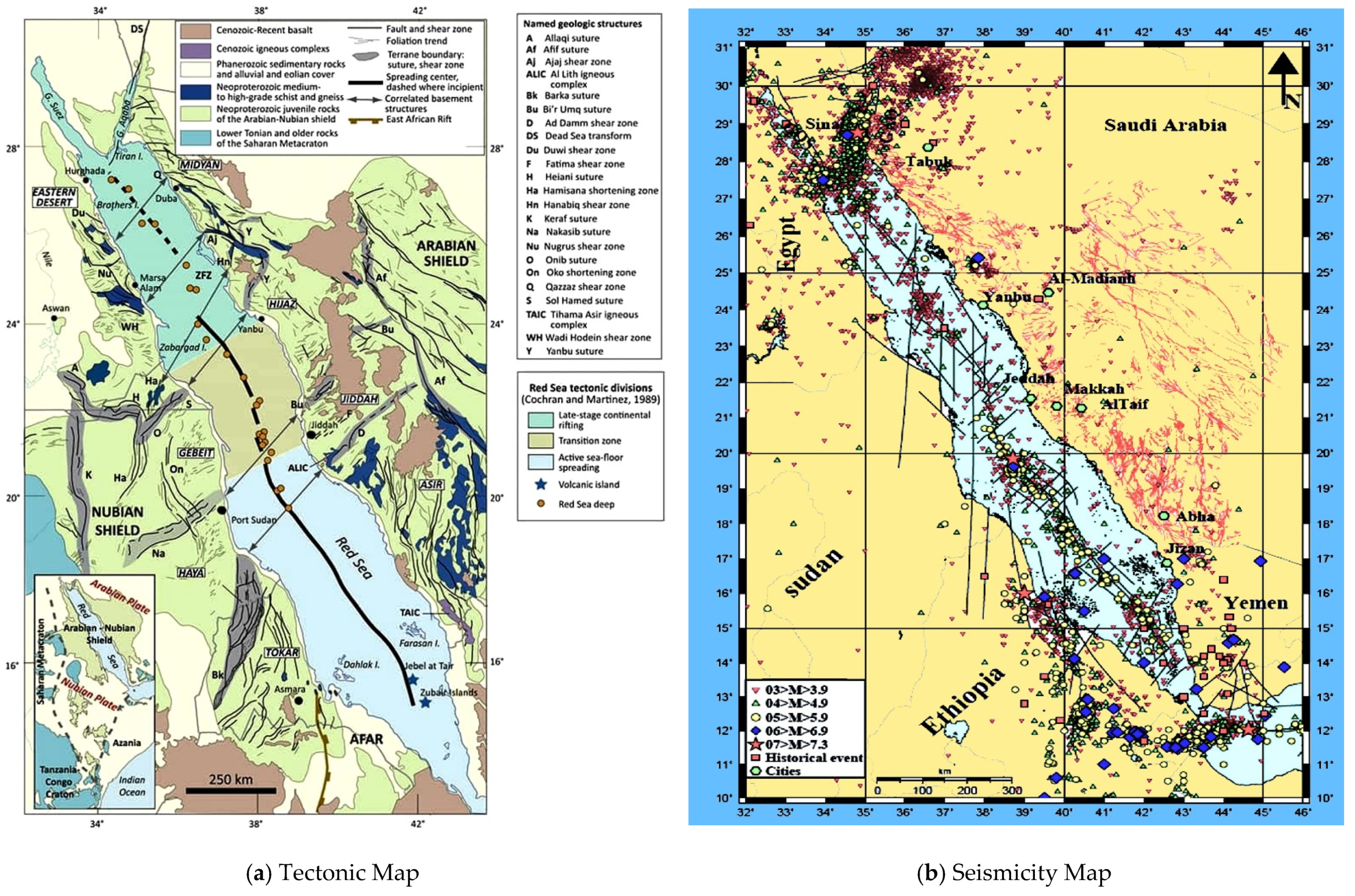
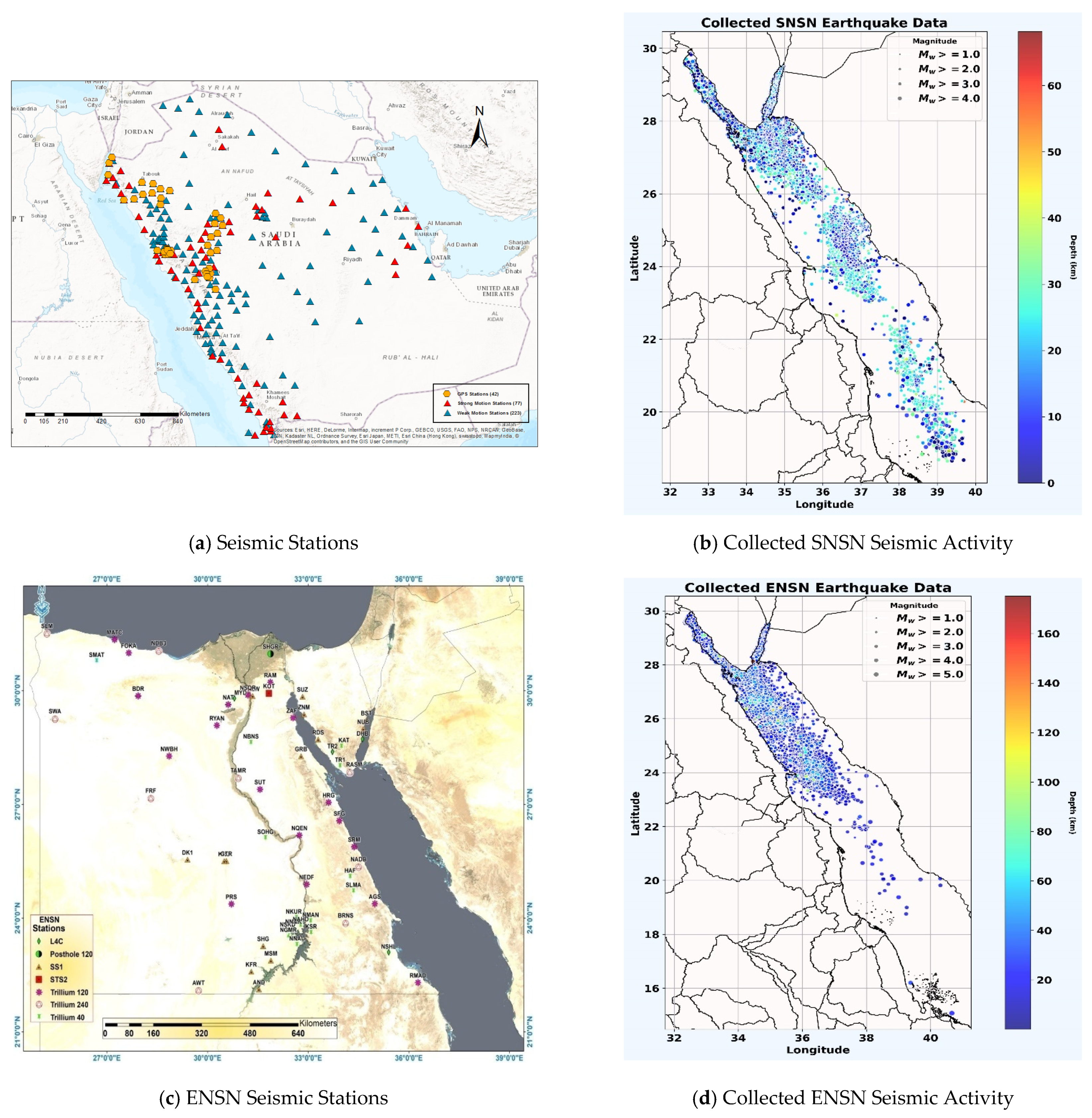
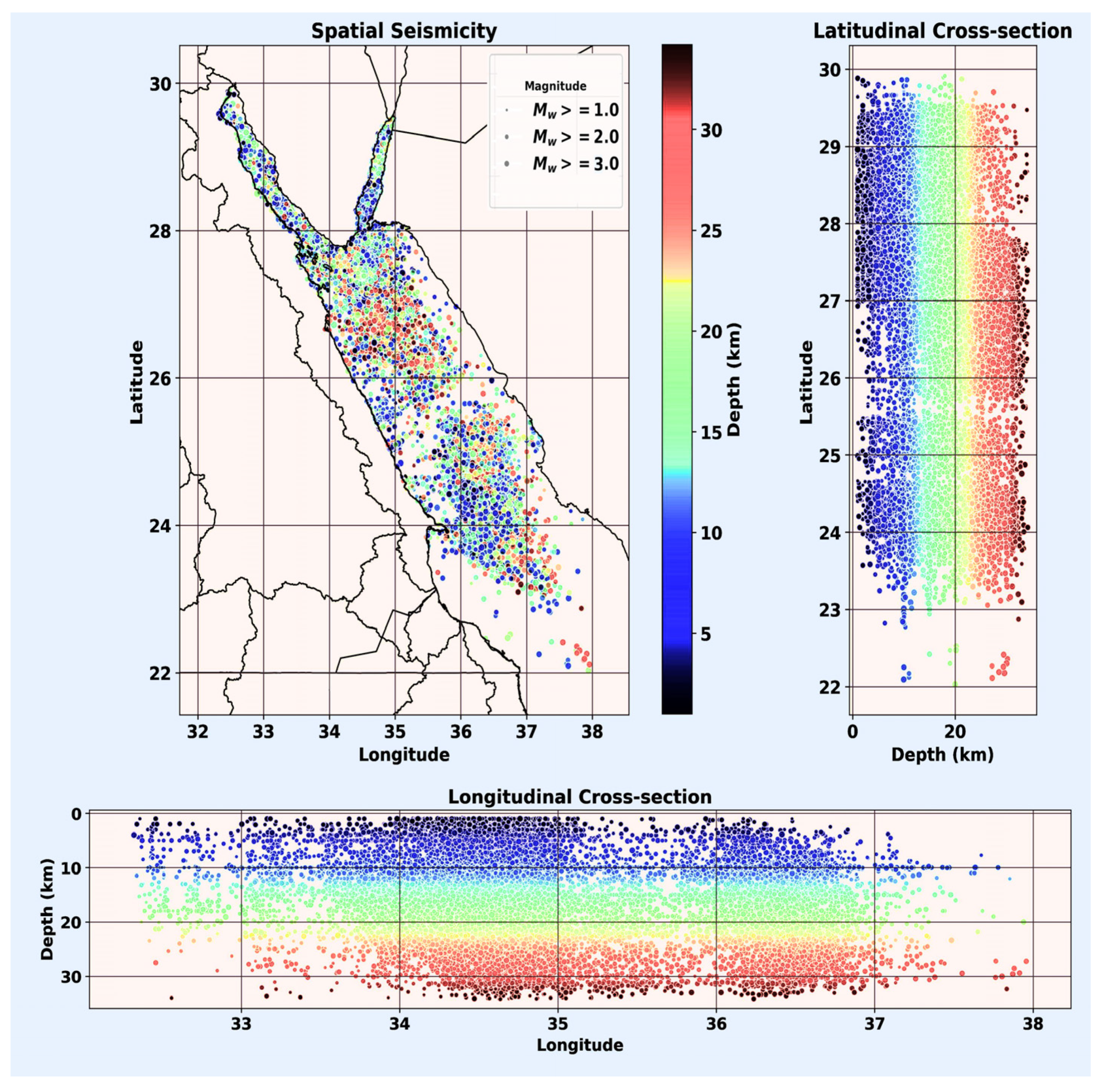




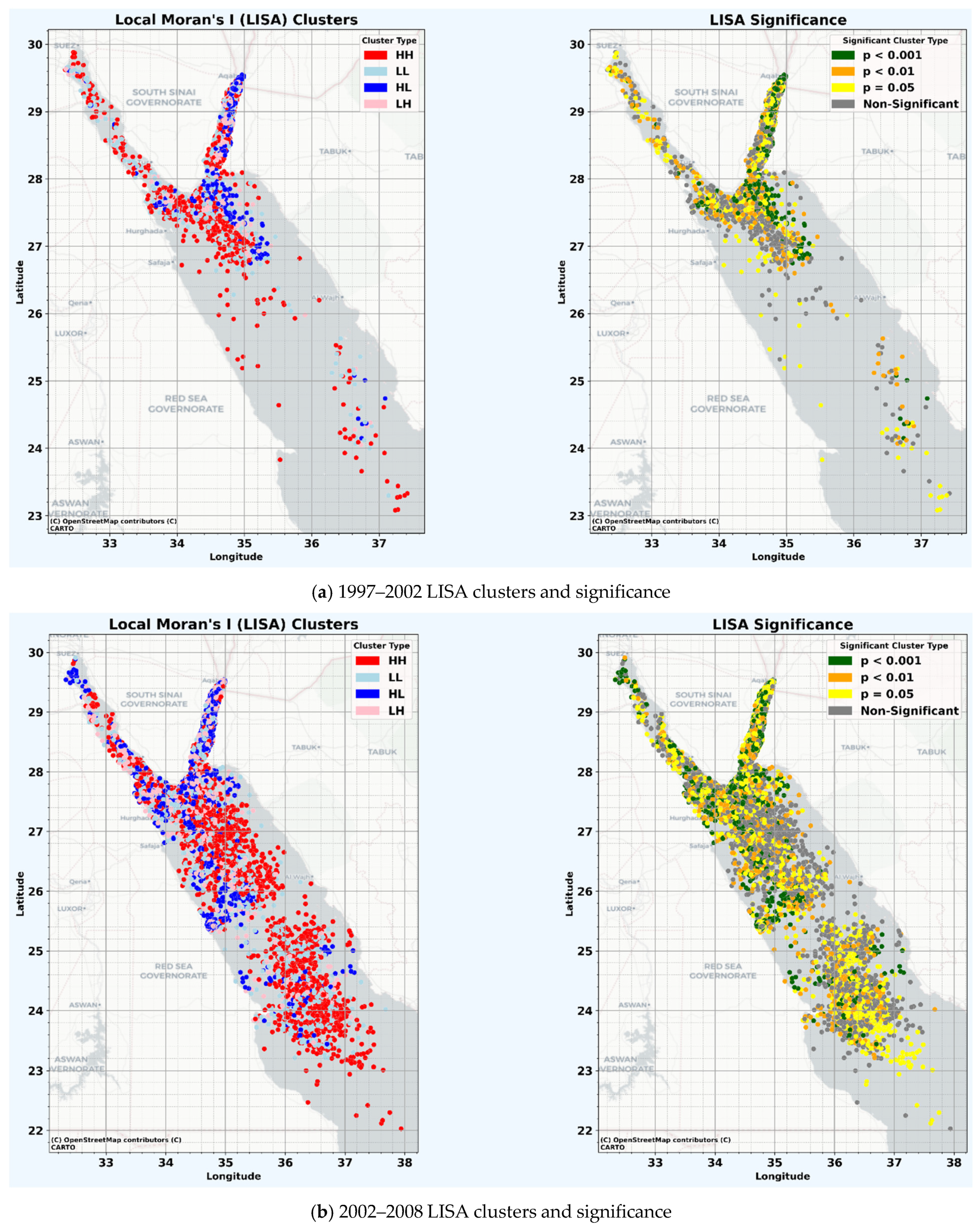

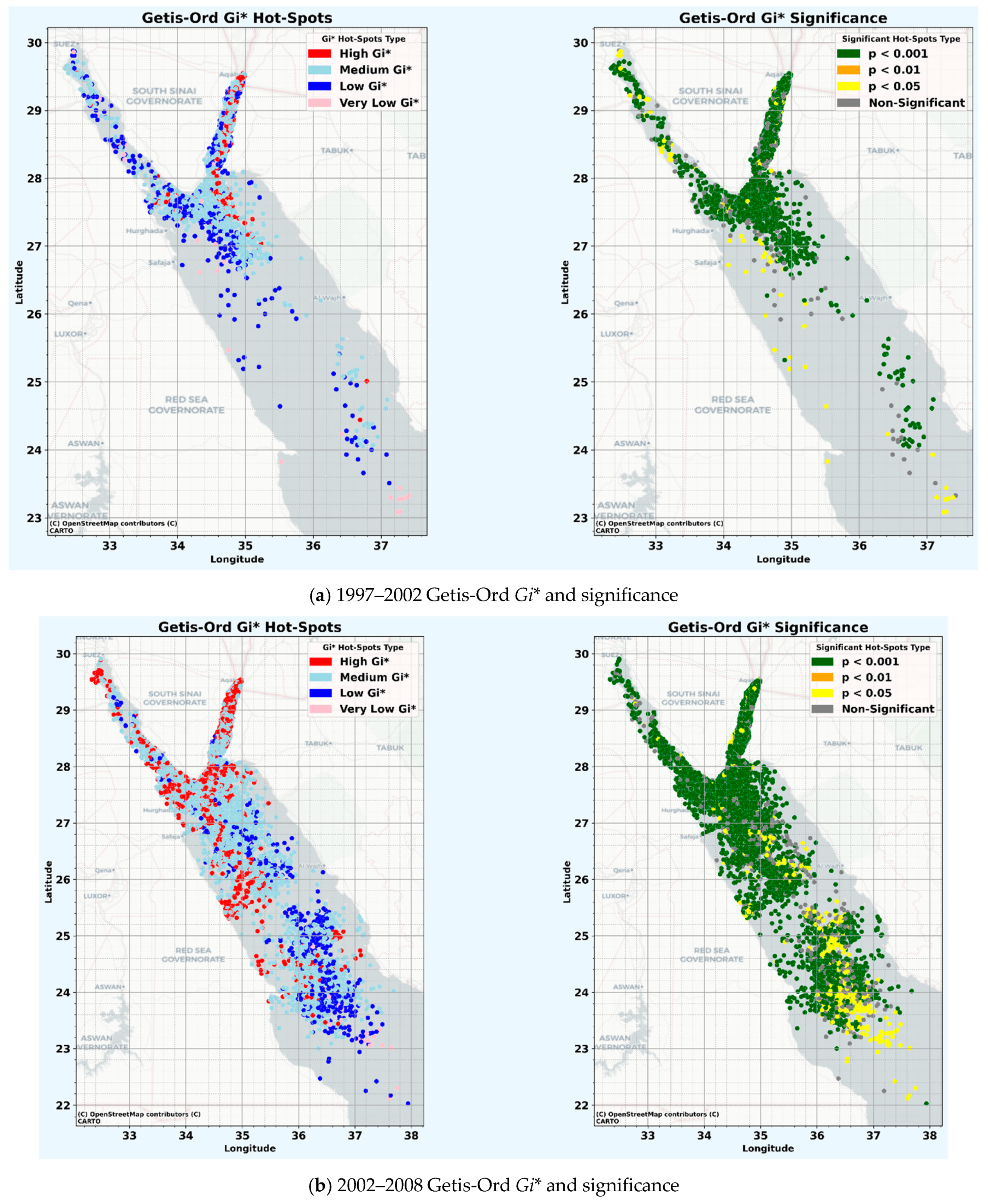
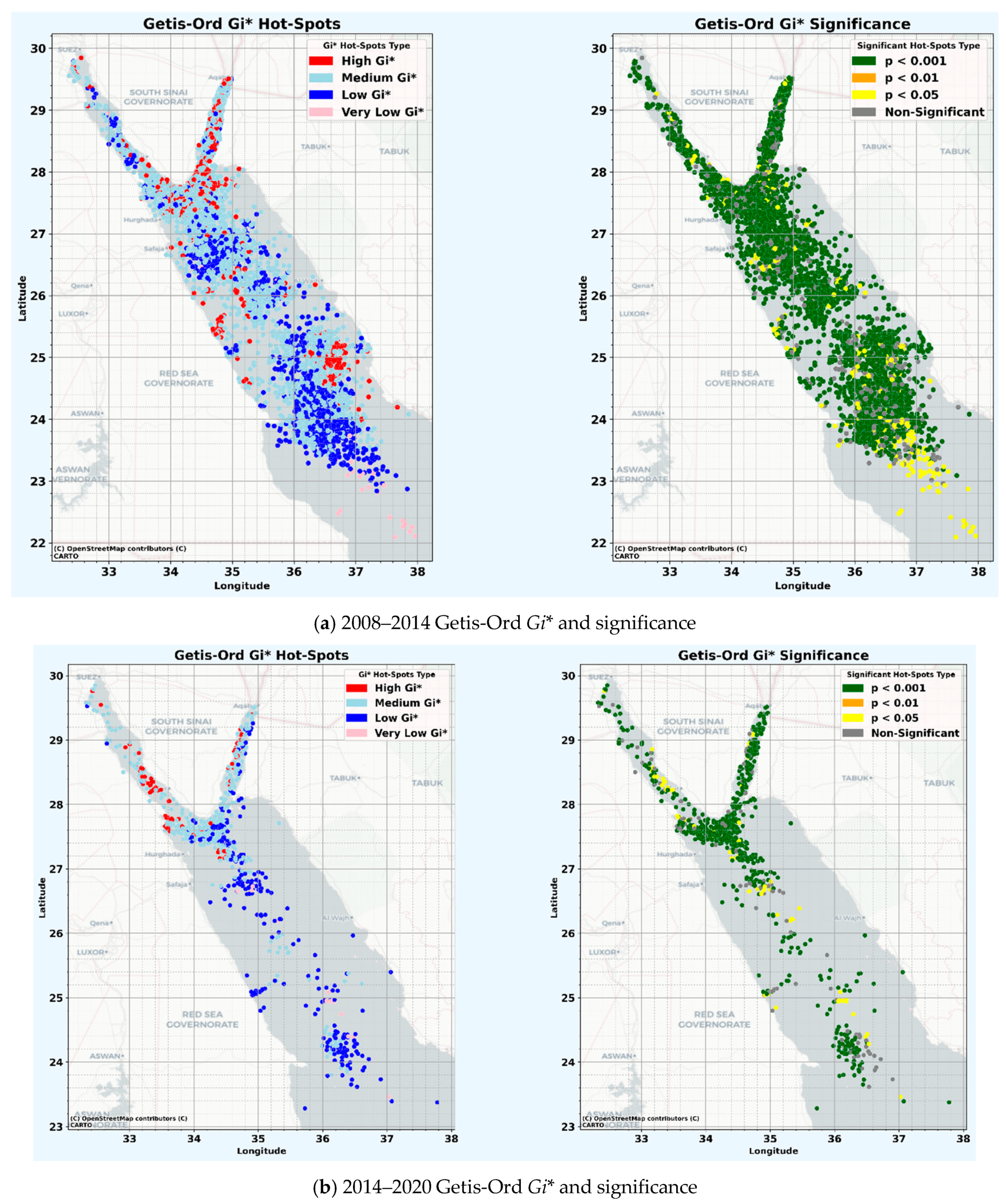
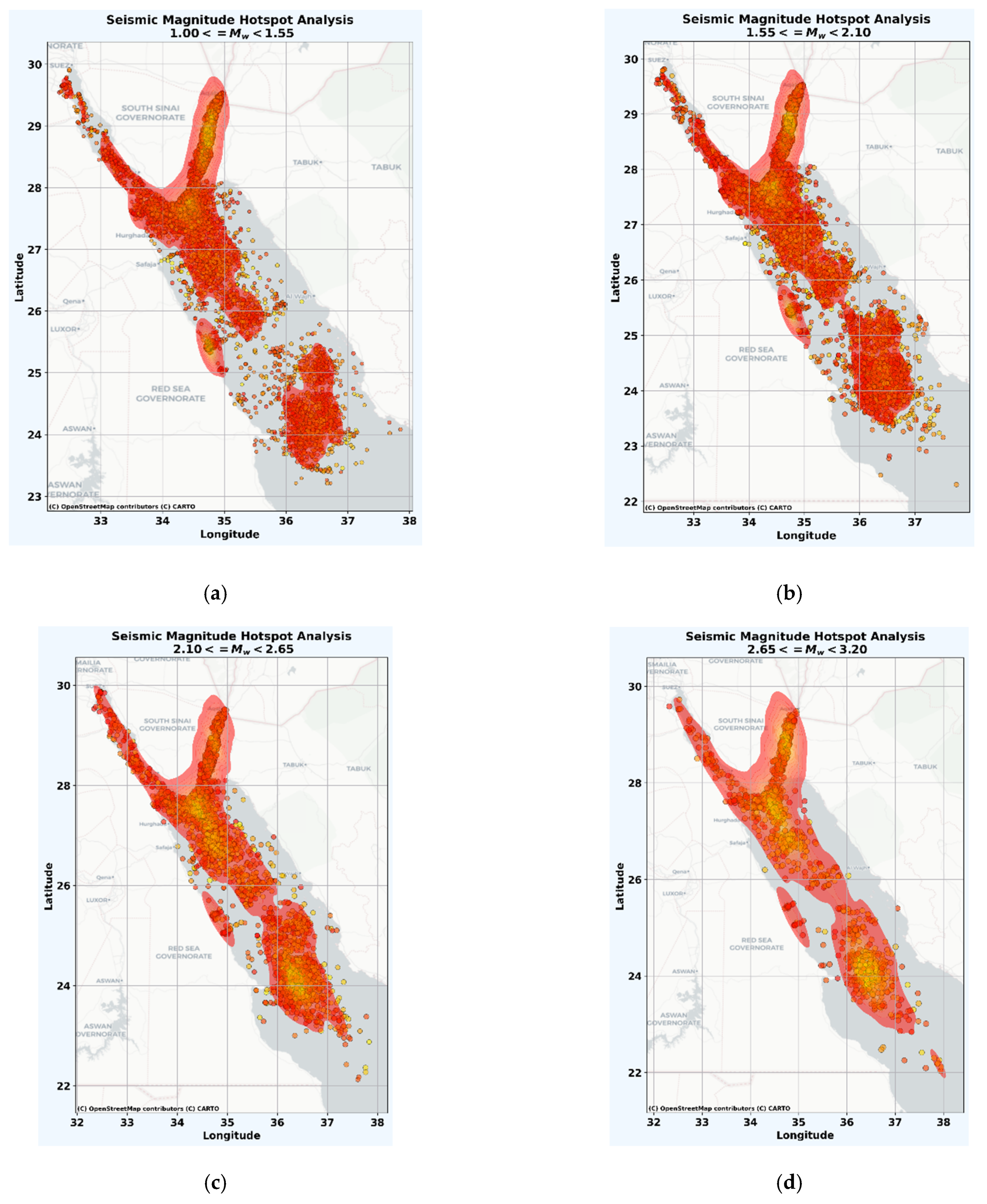
| Dataset | Statistic | Year | Month | Day | Hour | Minute | Second | Latitude | Longitude | Depth | Magnitude |
|---|---|---|---|---|---|---|---|---|---|---|---|
| count | 50,747 | 50,747 | 50,747 | 50,747 | 50,747 | 50,747 | 50,747 | 50,747 | 50,747 | 50,648 | |
| mean | 2008 | 6.42 | 15.82 | 12.17 | 29.31 | 29.88 | 26.72 | 34.80 | 15.42 | 1.62 | |
| std | 5.28 | 3.46 | 8.83 | 7.55 | 17.18 | 17.30 | 1.62 | 0.93 | 7.52 | 1.30 | |
| ENSN | min | 1998 | 1 | 1 | 0 | 0 | 0 | 15.08 | 32.32 | 0.01 | 0.9 |
| 25% | 2005 | 3 | 8 | 5 | 14 | 14.85 | 25.41 | 34.28 | 10 | 1.1 | |
| 50% | 2007 | 6 | 16 | 14 | 29 | 29.78 | 27.40 | 34.64 | 15 | 1.63 | |
| 75% | 2012 | 9 | 23 | 19 | 44 | 45.00 | 27.72 | 35.20 | 19.98 | 2.1 | |
| max | 2022 | 12 | 31 | 23 | 59 | 59.99 | 29.95 | 40.67 | 75.19 | 5.7 | |
| count | 51,531 | 51,531 | 51,531 | 51,531 | 51,531 | 51,531 | 51,531 | 51,531 | 51,531 | 51,531 | |
| mean | 2005 | 6.60 | 15.92 | 11.67 | 29.48 | 29.99 | 27.64 | 35.01 | 13.57 | 1.61 | |
| std | 6.05 | 3.46 | 8.70 | 7.40 | 17.17 | 17.31 | 1.78 | 0.89 | 8.24 | 0.80 | |
| SNSN | min | 1988 | 1 | 1 | 0 | 0 | 0 | 18.65 | 32.39 | 0.00 | 0.12 |
| 25% | 2002 | 4 | 8 | 5 | 15 | 15.00 | 27.39 | 34.61 | 8.47 | 1.00 | |
| 50% | 2004 | 7 | 16 | 12 | 29 | 30.00 | 28.24 | 34.74 | 13.70 | 1.50 | |
| 75% | 2008 | 10 | 23 | 18 | 44 | 45.00 | 28.83 | 34.88 | 18.48 | 2.00 | |
| max | 2020 | 12 | 31 | 23 | 59 | 59.98 | 29.86 | 39.71 | 68.15 | 4.35 |
| Statistic | Year | Month | Day | Hour | Minute | Second | Latitude °N | Longitude °E | Depth (km) | Magnitude Mw |
|---|---|---|---|---|---|---|---|---|---|---|
| count | 37,730 | 37,730 | 37,730 | 37,730 | 37,730 | 37,730 | 37,730 | 37,730 | 37,730 | 37,730 |
| mean | 2006 | 6.34 | 15.89 | 12.04 | 29.27 | 29.82 | 27.15 | 34.88 | 15.04 | 1.66 |
| std | 3.93 | 3.45 | 8.77 | 7.48 | 17.17 | 17.38 | 1.67 | 0.79 | 6.85 | 0.51 |
| min | 1997 | 1.00 | 1.00 | 0.00 | 0.00 | 0.00 | 22.03 | 32.32 | 1.00 | 1.00 |
| 25% | 2003 | 3.00 | 8.00 | 5.00 | 14.00 | 14.70 | 25.48 | 34.49 | 10.00 | 1.20 |
| 50% | 2005 | 6.00 | 16.00 | 13.00 | 29.00 | 30.00 | 27.61 | 34.73 | 14.60 | 1.64 |
| 75% | 2009 | 9.00 | 23.00 | 19.00 | 44.00 | 45.00 | 28.51 | 34.90 | 19.50 | 2.00 |
| max | 2020 | 12.00 | 31.00 | 23.00 | 59.00 | 59.99 | 29.91 | 37.96 | 34.21 | 3.20 |
| Magnitude Range | ANN Distance | Mean | Z-Score | p-Value | Detected Pattern |
|---|---|---|---|---|---|
| 1.00–1.55 | 0.00647 | 0.02350 | −307.93 | 0.000013 | Clustered |
| 1.55–2.10 | 0.00776 | 0.02633 | −294.62 | 0.000059 | Clustered |
| 2.10–2.65 | 0.01656 | 0.04702 | −158.48 | 0.000071 | Clustered |
| 2.65–3.20 | 0.03031 | 0.08822 | −86.970 | 0.000066 | Clustered |
| Year Range | |||||
| 1997–2002 | 0.00962 | 0.04228 | −140.66 | 0.000020 | Clustered |
| 2002–2008 | 0.00564 | 0.02282 | −393.49 | 0.000009 | Clustered |
| 2008–2014 | 0.01034 | 0.03084 | −252.56 | 0.000081 | Clustered |
| 2014–2020 | 0.03012 | 0.10284 | −66.440 | 0.000063 | Clustered |
| Magnitude Range | Mean | Variance | Z-Score | p-Value | Detected Pattern |
|---|---|---|---|---|---|
| 1.00–1.55 | 1.1831 | 0.0342 | 75.3441 | 0.000023 | Clustering |
| 1.55–2.10 | 1.8640 | 0.0248 | 54.2673 | 0.000016 | Clustering |
| 2.10–2.65 | 2.3101 | 0.0255 | −47.4820 | 0.000056 | Dispersion |
| 2.65–3.20 | 2.8529 | 0.0194 | −82.7884 | 0.000079 | Dispersion |
| Year Range | |||||
| 1997–2002 | 2000 | 0.9385 | −43.6551 | 0.000035 | Dispersion |
| 2002–2008 | 2004 | 2.0619 | 121.4927 | 0.000054 | Clustering |
| 2008–2014 | 2010 | 2.1741 | 20.37150 | 0.000044 | Clustering |
| 2014–2020 | 2016 | 3.1774 | −88.4000 | 0.000022 | Dispersion |
| Magnitude Range | GMI Index | Mean Magnitude | Z-Score | p-Value | Detected Pattern |
|---|---|---|---|---|---|
| 1.00–1.55 | 0.143011 | 1.183140 | 24.870270 | 0.000001 | Clustered |
| 1.55–2.10 | 0.107987 | 1.863986 | 17.478009 | 0.000003 | Clustered |
| 2.10–2.65 | 0.042225 | 2.310083 | 3.895662 | 0.000098 | Clustered |
| 2.65–3.20 | 0.067881 | 2.852866 | 3.408918 | 0.000652 | Clustered |
| Magnitude Range | LMI Index | Mean Magnitude | Z-Score | p-Value | Detected Pattern |
|---|---|---|---|---|---|
| 1.00–1.55 | 0.123003 | 1.183140 | 0.224410 | 0.005188 | Clustered |
| 1.55–2.10 | 0.090980 | 1.863986 | 0.175247 | 0.007915 | Clustered |
| 2.10–2.65 | 0.029216 | 2.310083 | 0.063909 | 0.001094 | Clustered |
| 2.65–3.20 | 0.062832 | 2.852866 | 0.083825 | 0.006475 | Clustered |
Disclaimer/Publisher’s Note: The statements, opinions and data contained in all publications are solely those of the individual author(s) and contributor(s) and not of MDPI and/or the editor(s). MDPI and/or the editor(s) disclaim responsibility for any injury to people or property resulting from any ideas, methods, instructions or products referred to in the content. |
© 2024 by the authors. Licensee MDPI, Basel, Switzerland. This article is an open access article distributed under the terms and conditions of the Creative Commons Attribution (CC BY) license (https://creativecommons.org/licenses/by/4.0/).
Share and Cite
Moustafa, S.S.R.; Yassien, M.H.; Metwaly, M.; Faried, A.M.; Elsaka, B. Applying Geostatistics to Understand Seismic Activity Patterns in the Northern Red Sea Boundary Zone. Appl. Sci. 2024, 14, 1455. https://doi.org/10.3390/app14041455
Moustafa SSR, Yassien MH, Metwaly M, Faried AM, Elsaka B. Applying Geostatistics to Understand Seismic Activity Patterns in the Northern Red Sea Boundary Zone. Applied Sciences. 2024; 14(4):1455. https://doi.org/10.3390/app14041455
Chicago/Turabian StyleMoustafa, Sayed S. R., Mohamed H. Yassien, Mohamed Metwaly, Ahmad M. Faried, and Basem Elsaka. 2024. "Applying Geostatistics to Understand Seismic Activity Patterns in the Northern Red Sea Boundary Zone" Applied Sciences 14, no. 4: 1455. https://doi.org/10.3390/app14041455
APA StyleMoustafa, S. S. R., Yassien, M. H., Metwaly, M., Faried, A. M., & Elsaka, B. (2024). Applying Geostatistics to Understand Seismic Activity Patterns in the Northern Red Sea Boundary Zone. Applied Sciences, 14(4), 1455. https://doi.org/10.3390/app14041455









